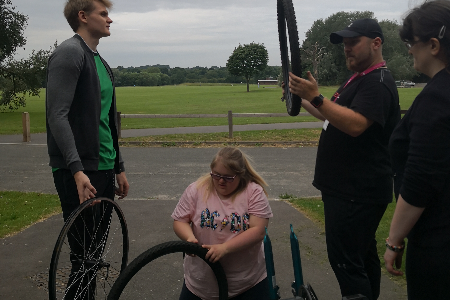
Cycling with a disability provides cycling training and maintenance sessions for people with learning and communication disabilities, as well and their families. The aims of the sessions are to improve participants’ physical, mental and social well-being. All activities need to be run by a cycle trainer, preferably somebody who has relevant experience in working with and supporting disabled people. Sessions will be for individuals and groups to cater to different skill levels. In addition to this, there are also sessions on what the benefits of cycling are, for example providing independence, transport, and contributing to a healthy lifestyle. This project also provides many opportunities for social activities after the cycling sessions; projects could offer lunch/brunch, quizzes, board games, excursions, or just the chance to sit and chat.
Existing cyclists can be recruited to volunteer at the sessions, which has the added benefit of upskilling non-participants and non-family members.
Each training session lasts about two hours (1 hour cycling and 1 hour maintenance) and the additional sessions on the benefits of cycling can last between 1-2 hours. Both sessions are weekly and run for 8 weeks.
Target audience and engagement
• The key target audience is people with learning and communication disabilities and their families
• Promotion is mostly through local community channels and the recruitment of volunteers through local sports channels
• Flyers, posters and social media can also be useful tools for promotion
Reach
• Large (100-200 participants including family members)
• Geographically - any community centre or local building, preferably with a garden large enough for cycling or very easy access to a suitable park or cycling facilities. So long as it is an optimal setting for people with learning and communication disabilities and their families to experience cycling in a completely safe and secure environment
Equipment needed
• Bikes of various sizes (or you could ask participants to bring their own)
• Helmets of various sizes
• Maintenance kit
• Basic spare bike parts
Resources needed
• Cycle Instructor:
-Run the cycling sessions
-Ensure participants feel confident and well looked-after
-Must be a qualified and experienced instructor, preferably with experience working with people with learning and communication disabilities
• Project Leader:
-Oversee the project ensuring the participants feel safe and are enjoying their time
-Ensure all funding criteria and documentation is met (if required)
-Run risk assessment for safeguarding, injuries and to identify any other concerns which may affect project delivery
-Gather feedback from participants
-The Project Lead should have the requisite level of DBS and understand health and safety needs (preferably First Aid trained)
• Volunteers:
-Help participants with the sessions and provide encouragement
-Contribute to overseeing the activity and potentially fix any equipment issues
• Storage space:
-You will need somewhere to store equipment. This can be at the building you run the sessions (providing there is the space and you have permission), alternatively you could ask at a community centre, or perhaps another local business that has storage room. Your Council may be able to provide you with information on who to contact. You could also use a shipping container, see if anyone is willing to lend you one, otherwise you could buy one as a last resort. Try to keep this as close to the location of the sessions as possible
• Refreshments:
-Tea, coffee and lunch/brunch after every session, this will lighten the mood and offers an incentive for people to come
Estimated project costs
• Bikes of different sizes (£250 per bike) x10 £2,500
• Cycle Instructor £2,000
• Helmets £150
• Maintenance kit and spare parts £150
• Project Manager £500
• Flyers and posters £100
• Refreshments £100
Top tips/key learnings
• In the group sessions, try to keep the number of participant’s low, maximum 6 per session. This makes them less intimidating, and people are more likely to form closer friendships. It also means participants get much more one-to-one time with the instructor and volunteers
• Try to keep the sessions fun and relaxed
• It’s good to measure whether participants are more or less confident in riding a bike, or whether they feel encouraged to try riding bikes more. This is done by a ‘hands up’ survey or with a questionnaire, where participants are asked to confirm or not, certain statements about their view of cycling
• Try to mix up the after session activities, really use the 8 weeks you have with the participants to think of really interesting things to do!
Maximising local contacts
• Utilise networks to recruit participants or even get in kind support. (Disability groups, volunteer organisations and local centres, community centres, schools, etc.)
• Engage with your council – they may be able to lend you equipment, help market the project and help secure a space.
This project idea was provided by Bromley Mencap - Twitter - Instagram
If you decide to run your own version of this project in your community, please email us at wcgl@groundwork.org.uk. We love to hear that we are inspiring people to walk and cycle.